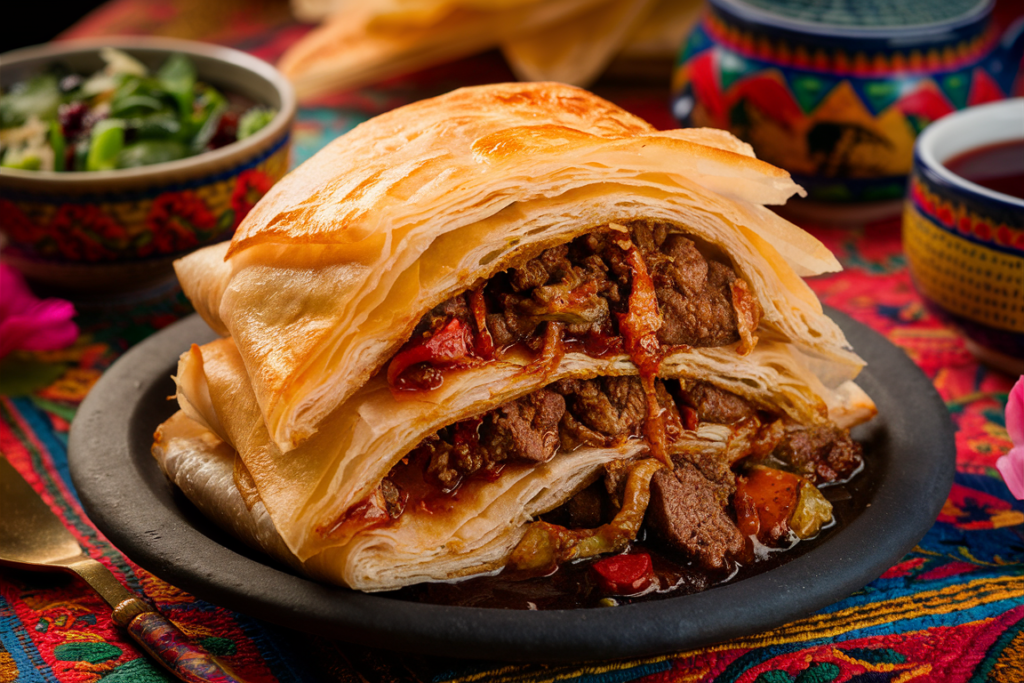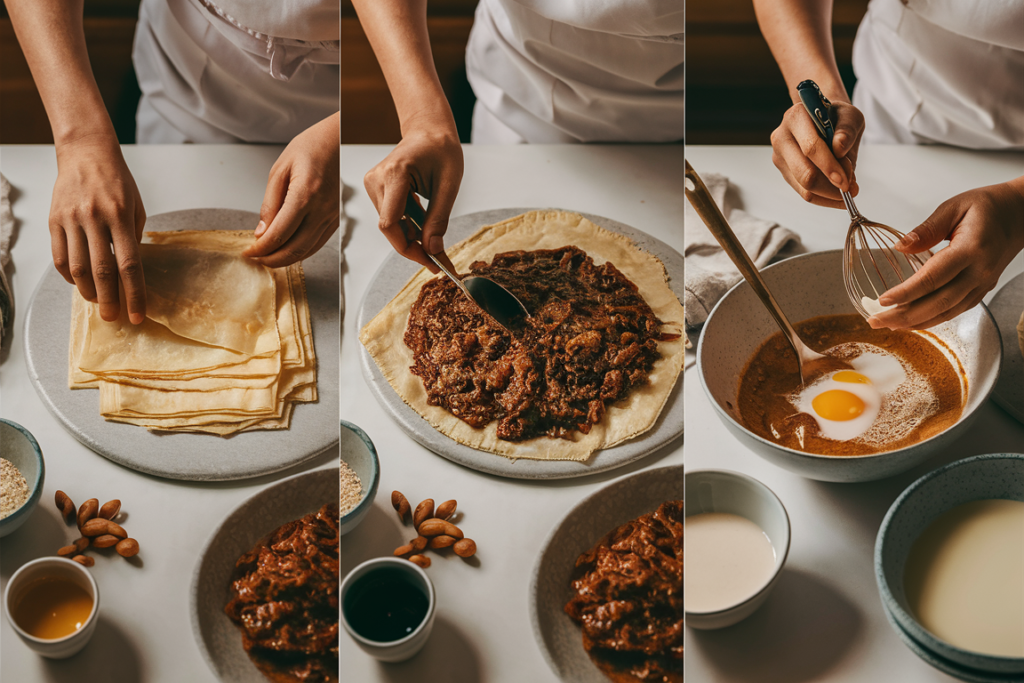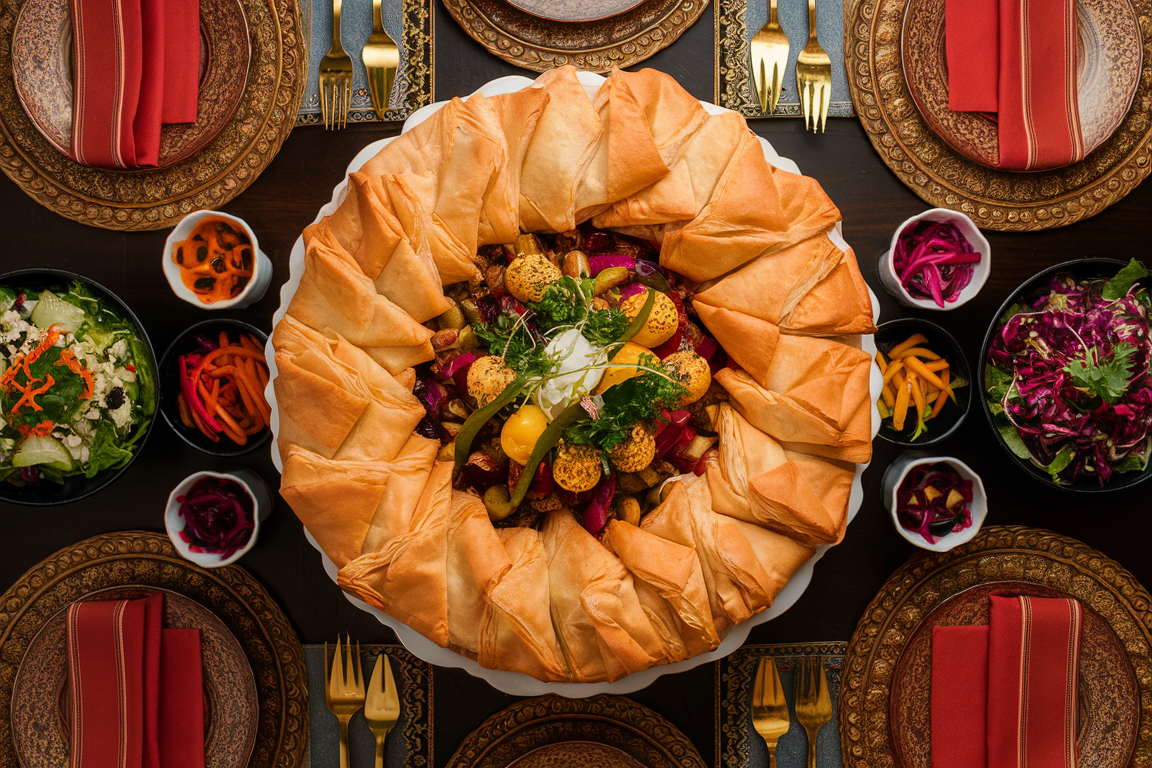Part 1: Introduction
What is Egyptian Goulash?
Egyptian Goulash, also known as “Goulash Masri”, is a savory pastry dish that blends flaky filo dough with a rich meat filling. Unlike the Hungarian goulash, which is a stew, this dish is more akin to a meat pie. Layers of crispy pastry encase a flavorful ground meat filling, often seasoned with onions, garlic, and spices, then baked to golden perfection.
Its unique texture and taste make it a beloved staple in Egyptian households. Whether served as a main course or an appetizer, this savory pastry is perfect for family dinners and festive gatherings.
Historical Background of Egyptian Goulash
The origins of this dish trace back to Ottoman influences in Egyptian cuisine. The widespread use of filo dough in Middle Eastern recipes, such as baklava and börek, laid the foundation for this delightful creation.
While Hungarian goulash and its Egyptian counterpart share a name, the similarity ends there. This savory pastry adopted the name during the colonial period, reflecting a fusion of European and Middle Eastern culinary traditions. Over time, it became a hallmark of Egypt’s vibrant culinary identity.

The Cultural Significance of Egyptian Goulash
In Egypt, food often symbolizes community and family, and this dish is no exception. It’s a popular choice during Ramadan, frequently served after the evening prayer as part of the iftar meal. Its shareable portions and rich flavors make it a favorite for gatherings.
Beyond religious celebrations, this savory pastry has become a cherished comfort food, reflecting a blend of tradition and modernity. From upscale restaurants to humble street vendors, it enjoys widespread appreciation across all social classes.
Key Ingredients
The beauty of Egyptian Goulash lies in its simplicity. Common ingredients include:
- Filo Dough: Thin, flaky pastry sheets that form the layers.
- Ground Meat: Typically beef or lamb, seasoned with onions and spices.
- Onions and Garlic: Essential for the aromatic base.
- Butter or Ghee: To brush the filo layers for a crispy texture.
- Eggs and Milk: Used to bind the layers during baking.
For modern variations, vegetarian options like spinach and cheese fillings are gaining popularity.
Traditional vs. Modern Variations
The traditional version of Egyptian Goulash sticks to ground meat and minimal seasoning, letting the natural flavors shine. However, modern twists have introduced ingredients like:
- Spicy minced lamb for a bold kick.
- Vegetables like spinach, zucchini, or mushrooms for vegetarians.
- Cheese layers for added richness.
These adaptations showcase the dish’s versatility while keeping its cultural essence intact.
Egyptian Goulash vs. Hungarian Goulash – A Comparison
While the two share a name, their differences are striking:
- Hungarian Goulash: A hearty soup or stew made with beef, vegetables, and paprika.
- Egyptian Goulash: A baked filo pastry dish with ground meat filling.
The contrast highlights how culinary names can evolve across regions, reflecting local ingredients and techniques.
Why Egyptian Goulash is Popular in Middle Eastern Cuisine
The popularity of Egyptian Goulash in the Middle East stems from its:
- Accessibility: Simple ingredients make it easy to prepare.
- Flavor: Layers of spiced meat and crispy pastry appeal to diverse palates.
- Versatility: Suitable for everyday meals or festive celebrations.
Its adaptability has made it a staple not just in Egypt but across Middle Eastern countries.
Regional Variations
While the base recipe remains consistent, regional adaptations add unique flair:
- Alexandria: Often includes a spiced tomato sauce.
- Cairo: Sticks to the traditional meat filling.
- Sinai: Features a lamb-based filling with Bedouin spices.
These variations celebrate local tastes while staying true to the essence of Egyptian Goulash.
Health Benefits of the Ingredients in Egyptian Goulash
The dish combines nutrition with indulgence. Key health benefits include:
- High Protein: From the ground meat filling.
- Rich in Iron: Thanks to the inclusion of red meat.
- Vitamins and Antioxidants: From onions and garlic.
- Controlled Portions: Filo layers ensure a balanced ratio of pastry to filling.
For a healthier twist, whole-grain filo dough and lean meats can be used.
Egyptian Goulash as a Versatile Dish – Appetizer or Main Course
One of the reasons for its enduring popularity is its versatility. As an appetizer, it’s often cut into bite-sized pieces, while as a main course, it’s served in larger slices alongside salads or soups.
Part 2: Step-by-Step Guide to Making Egyptian Goulash
Crafting the perfect Egyptian Goulash requires patience, precision, and attention to detail. The process includes preparing the filo dough, creating a flavorful filling, and baking to perfection. Below is a detailed guide to mastering this dish.
Preparing the Filo Dough for Goulash
The foundation of Egyptian Goulash lies in its filo dough, which provides the signature flaky texture. Here’s how to handle it:
- Defrost Properly: Filo dough is delicate, so ensure it thaws in the refrigerator overnight.
- Keep it Moist: Cover the dough with a damp cloth while working to prevent it from drying out.
- Layer Generously: Brush each sheet with melted butter or ghee for the perfect golden crisp.
Using store-bought filo dough simplifies the process, but homemade filo adds a personal touch.

Creating the Perfect Meat Filling for Egyptian Goulash
The filling is the heart of the dish. Traditional recipes use ground beef or lamb, but you can adapt it based on dietary preferences.
- Sauté Aromatics: Cook diced onions and minced garlic in a skillet with a splash of oil until golden.
- Add Meat: Incorporate ground beef or lamb, breaking it into small pieces as it cooks.
- Season Generously: Use spices like cinnamon, nutmeg, salt, and pepper for authentic Egyptian flavors.
- Drain Excess Fat: Ensure the filling isn’t overly greasy to keep the pastry layers intact.
For vegetarians, a mixture of spinach, feta cheese, and herbs like dill and parsley makes a delightful alternative.
Tips for Layering Filo Dough and Meat Mixture
To achieve a balanced texture, layering is key:
- Base Layers: Start with 5–6 buttered filo sheets at the bottom of your baking dish.
- Middle Layer: Spread the cooked meat filling evenly.
- Top Layers: Cover with another 5–6 buttered filo sheets, ensuring the edges are tucked in neatly.
Press gently between layers to create a compact, cohesive dish.
Baking Techniques for a Golden, Crispy Texture
Achieving the perfect bake is essential for Egyptian Goulash. Follow these steps:
- Preheat the Oven: Set to 350°F (175°C) for consistent cooking.
- Egg and Milk Wash: Whisk eggs with milk and pour it evenly over the layered pastry. This binds the layers and adds moisture.
- Bake to Perfection: Bake for 30–40 minutes or until the top turns golden brown.
- Cool Before Serving: Allow it to rest for 10 minutes to set before slicing.
Vegetarian and Vegan Alternatives for Egyptian Goulash
Adapting Egyptian Goulash for different diets is straightforward:
- Vegetarian Option: Use a mix of cheese (feta, ricotta) and sautéed spinach as a filling.
- Vegan Option: Replace butter with olive oil and use a vegetable filling like mushrooms, zucchini, and peppers. Swap the egg wash with almond milk for binding.
These variations retain the essence of the dish while catering to diverse preferences.
Common Mistakes to Avoid When Making Egyptian Goulash
Avoiding these pitfalls ensures success:
- Overly Wet Filling: Draining meat properly is crucial to prevent soggy pastry.
- Skipping Butter/Ghee: This step is vital for crisp, flaky layers.
- Uneven Layers: Take your time to spread the filling and filo dough evenly.
- Overbaking: Watch closely during the final minutes to avoid burning the top layer.
Tools and Equipment Needed for Egyptian Goulash
Here’s what you’ll need:
- Baking dish (preferably glass or ceramic)
- Pastry brush for buttering the filo dough
- Sharp knife for slicing before baking
- Large skillet for preparing the filling
Investing in quality tools simplifies the process and ensures better results.
Time Management Tips for Preparing Egyptian Goulash
Streamlining the preparation can make the process less daunting:
- Prep Ahead: Cook the filling in advance and store it in the refrigerator for up to two days.
- Use Frozen Filo Dough: It saves time compared to making it from scratch.
- Assemble Early: Prepare the dish in the morning, then bake just before serving.
Storing and Reheating Egyptian Goulash
If you have leftovers, storing and reheating properly will maintain their flavor and texture:
- Storage: Cover with plastic wrap or foil and refrigerate for up to three days.
- Reheating: Place in the oven at 300°F (150°C) for 10–15 minutes to restore crispiness.
Avoid microwaving, as it can make the pastry soggy.
Part 3: Serving and Pairing Egyptian Goulash
Best Side Dishes to Serve with Egyptian Goulash
Egyptian Goulash pairs beautifully with a variety of side dishes that complement its rich, savory flavors. Here are some popular choices:
- Middle Eastern Salads: A tangy fattoush or tabbouleh brings freshness and balance.
- Rice Pilaf: Lightly spiced basmati rice or riz bil sha’arieh (vermicelli rice) adds a hearty touch.
- Pickled Vegetables: Pickles like turnips or cucumbers offer a burst of acidity to cut through the richness.
- Yogurt Dip: A simple tzatziki-style dip enhances the dish’s flavors and provides a cooling element.
These pairings not only enhance the meal but also create a harmonious dining experience.
Traditional Egyptian Beverages to Complement the Dish
Beverages play a key role in Middle Eastern cuisine, and Egyptian Goulash is no exception. Some traditional drinks to accompany it include:
- Karkadeh (Hibiscus Tea): Served cold or warm, its tart flavor is a perfect counterpoint to the goulash’s richness.
- Ayran: This salty yogurt drink complements the pastry layers and meat filling.
- Mint Tea: A refreshing finish to a hearty meal.
- Sugarcane Juice: Popular in Egypt, this natural drink adds a touch of sweetness to balance the savory dish.
Presentation Tips for Serving Egyptian Goulash
To elevate your serving style, consider these presentation tips:
- Slice Evenly: Pre-cut the goulash into squares or diamonds before baking to make serving easier.
- Garnish: Sprinkle fresh parsley or a light dusting of paprika for a pop of color.
- Layered Platter: Serve slices on a flat platter with side dishes arranged around them for a visually appealing setup.
- Small Plates for Appetizers: Use smaller slices with individual ramekins of dips for appetizers.
Ideal Occasions for Making Egyptian Goulash
Egyptian Goulash is versatile enough to suit various occasions:
- Festive Celebrations: Ramadan iftar, Eid gatherings, or weddings.
- Family Dinners: Its easy preparation and shareable portions make it a great choice for weeknight meals.
- Potlucks: A dish that travels well and can be served warm or at room temperature.
- Special Events: Pair it with a mezze platter for a standout feature at dinner parties.
Its flexibility ensures it shines in any setting.
Pairing Egyptian Goulash with Middle Eastern Salads
Middle Eastern salads not only complement the goulash but also add variety to the table. Here are some classic options:
- Fattoush: Crisp lettuce, radishes, cucumbers, and fried pita tossed in a tangy sumac dressing.
- Tabbouleh: A parsley-heavy salad with bulgur, tomatoes, and lemon juice.
- Arabic Salad: A simple mix of chopped tomatoes, cucumbers, and bell peppers with olive oil and lemon.
- Beet Salad: Sweet roasted beets with a hint of citrus bring color and contrast.
These salads provide a refreshing counterpoint to the richness of the goulash.
How to Incorporate Egyptian Goulash in a Mezze Platter
Adding Egyptian Goulash to a mezze platter creates a delightful centerpiece. Here’s how to do it:
- Cut Smaller Slices: Serve bite-sized portions for easy handling.
- Pair with Dips: Include hummus, baba ghanoush, and muhammara for variety.
- Add Bread and Olives: Serve with warm pita bread, marinated olives, and stuffed grape leaves for a complete spread.
- Balance with Light Options: Incorporate lighter options like cucumber sticks and cherry tomatoes to keep the platter well-rounded.
This approach makes Egyptian Goulash a perfect choice for parties and gatherings.
Leftover Ideas for Egyptian Goulash
Leftover Egyptian Goulash can be transformed into new dishes:
- Breakfast Scramble: Chop into small pieces and mix with scrambled eggs for a hearty breakfast.
- Goulash Wraps: Wrap slices in pita bread with fresh lettuce and tahini sauce.
- Layered Casserole: Reassemble leftovers into a casserole dish with additional filo and bake.
- Snack Bites: Warm up small portions and serve with a spicy dipping sauce for an easy snack.
These ideas ensure nothing goes to waste and keep meals exciting.
Egyptian Goulash as a Holiday or Celebration Dish
In Egyptian households, goulash often takes center stage during:
- Ramadan: A fulfilling dish to break the fast.
- Eid Celebrations: Served alongside festive dishes like lamb and biryani.
- Weddings and Gatherings: Its easy portioning and universal appeal make it a crowd favorite.
- Christmas or New Year: A unique addition to holiday tables with global flavors.
Its association with celebration makes it a cherished tradition.
Variations of Egyptian Goulash Across Generations
As a dish passed down through generations, Egyptian Goulash has evolved:
- Grandparents’ Version: Simple and traditional, focusing on classic flavors.
- Parents’ Version: Incorporates modern ingredients like cheese or different spices.
- New Generations: Experiment with global influences, such as Mexican or Italian-inspired fillings.
This adaptability ensures it remains relevant and beloved.
Exploring Fusion Recipes Inspired by Egyptian Goulash
Chefs and home cooks worldwide have taken inspiration from Egyptian Goulash, creating fusion recipes like:
- Tex-Mex Goulash: Filled with spiced ground beef, beans, and cheddar cheese.
- Greek-Style Goulash: Features spinach and feta in place of meat.
- Italian Goulash: Uses layers of marinara sauce, mozzarella, and ground beef.
- Asian Fusion: Combines minced chicken, ginger, and soy sauce for a unique twist.
These variations highlight the global appeal of this Egyptian classic.
More FAQs About Egyptian Goulash
- Is Egyptian Goulash difficult to make? Not at all! With ready-made filo dough, it’s simple and quick to prepare.
- Can I make Egyptian Goulash ahead of time? Yes, assemble it ahead and bake it just before serving.
- What can I substitute for filo dough? Puff pastry or homemade dough works, though the texture will differ.
- Is Egyptian Goulash spicy? Traditionally, it’s mildly spiced, but you can adjust the heat to your preference.
- Can I freeze Egyptian Goulash? Yes, freeze unbaked goulash and bake it directly from frozen when needed.
- What’s the best meat for Egyptian Goulash? Ground beef or lamb are traditional, but you can experiment with chicken or turkey.
- Is Egyptian Goulash gluten-free? Not traditionally, but gluten-free filo dough is available.
- How do I prevent soggy filo? Ensure the filling isn’t too wet and bake until the pastry is golden and crispy.
- Can I make a dairy-free version? Replace butter with oil and use plant-based milk for the wash.
- What’s the origin of the name “goulash”? The name likely reflects historical influences from European cuisines, despite the differences in the dish itself.

